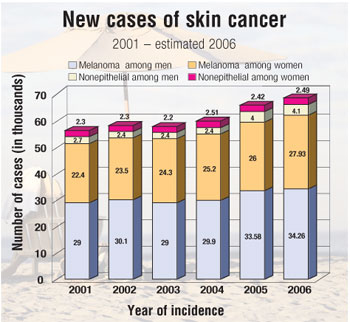The number of new melanoma cases
in the
Nonmelanomas
Nonmelanomas, usually
basal and squamous cell cancers, are the most common skin cancers. Basal cell
carcinoma occurs in the skin's upper layers and remains localized in the
original site. Squamous cell carcinoma can spread locally and disseminate
throughout the body. Both cancers are more common in individuals of fair
complexion who have had significant sunlight exposure and are curable with
early surgical removal.

Melanomas
Melanoma begins in
the melanocytes. Because most of these cells continue producing melanin,
melanoma tumors are often brown or black. Having a dark complexion lowers, but
does not eliminate, the risk of melanoma. Melanoma is likely to spread to
other parts of the body, but it is almost always curable in its early stages.
Comprising 4% of all skin cancers, melanoma is much less common than basal and
squamous cell skin cancers. However, it causes a large majority of skin cancer
deaths. One person dies every hour from melanoma.
Men and women often develop
melanoma on their upper back; women also commonly develop melanoma on their
legs. Once melanoma spreads to the lymph nodes and through the bloodstream,
there is no cure to treat the condition. Half of all melanomas are diagnosed
in people under age 57. More young women die from melanoma than from any other
cancer.
The American Cancer Society
(ACS) estimates that about 62,190 new melanomas will be diagnosed in the
About 7,910 deaths due to
melanomas are expected during 2006. Since 1973, the mortality rate has
increased by 50%. More recently, the death rate has leveled off for men and
dropped slightly in women. Precaution and early diagnosis could prevent
100,000 new cases and 60,000 deaths in the
Risk Factors
The exact causes of
melanomas are unknown, but certain risk factors are linked to the disease.
• Sun overexposure (UV
sunlight or indoor tanning) is the greatest risk. Excessive sun exposure for
the first 18 years of life increases risk.
• Fair-skinned persons
have four times the risk of dark-skinned people; redheads and blondes have a
two- to four-times greater risk than brunettes.
• People with numerous
or atypical moles have a higher risk. Families with many moles in multiple
generations have a greater risk.
• Family or personal
history of melanoma elevates risk.
• People treated with
medicines that suppress the immune system (e.g., transplant patients) have
increased risk.
New Developments in
Melanoma Treatment
Recently,
scientists have discovered a gene mutation in many melanomas. This gene,
BRAF, is an important discovery because doctors think that blocking the
activity of this gene may be a useful treatment for people with advanced
melanoma.
To comment on this article,
contact
editor@uspharmacist.com.






